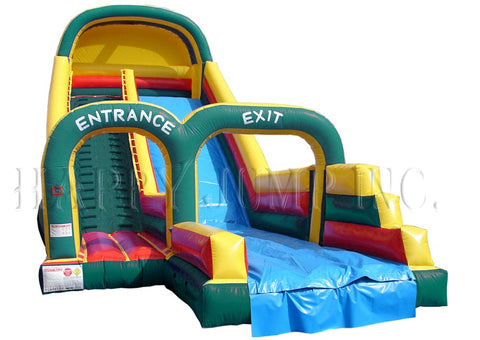
Are you ready to turn your passion for fun into a profitable business venture? Picture kids laughing, parents cheering, and colorful inflatables towering above. Imagine being the go-to provider for all things bouncy and exciting in your community. Whether you're dreaming of becoming your own boss or seeking a side hustle with serious potential, starting an inflatable rental business could be the answer you've been searching for. With the right strategy, you can transform your love for entertainment into a thriving enterprise. Follow our guide to learn how to launch your own inflatable rental business and start making waves in the industry today.
Keynotes
- Research and Planning: Conduct market research, secure permits, and draft a business plan.
- Investment Costs: Initial investment ranges from $5,000 to $30,000, covering equipment, transportation, insurance, permits, marketing, and miscellaneous expenses.
- Essential Equipment: Purchase inflatable units ($500 to $5,000+ each), air blowers ($100 to $500 each), and safety accessories ($100 to $500+), among other items.

Step 1: Research and Planning
Before diving into your first bounce house purchase, it's crucial to conduct thorough market research. Identify your target audience, analyze competitors, and assess demand in your area. Consider factors like demographics, local regulations, and seasonal trends. Draft a comprehensive business plan outlining your objectives, budget, pricing strategy, and marketing tactics. This roadmap will serve as your guiding light throughout the journey.
Step 2: Legalities and Permits
Navigate the legal landscape by registering your business, obtaining necessary permits, and securing liability insurance. Familiarize yourself with safety standards and regulations governing inflatable rentals in your jurisdiction. This ensures compliance and protects both your customers and your business from potential liabilities.
Step 3: Procurement of Equipment
Invest in high-quality inflatable units that are safe, durable, and visually appealing. Start with popular options like bounce houses, inflatable slides, obstacle courses, and interactive games. Establish relationships with reputable manufacturers or wholesalers to source your inventory. Don't forget to consider transportation and storage logistics when selecting equipment.
Step 4: Establish an Online Presence
In today's digital age, a strong online presence is indispensable. Create a professional website showcasing your offerings, pricing, and booking information. Leverage social media platforms to engage with your audience, share captivating content, and run targeted advertising campaigns. Encourage satisfied customers to leave reviews and testimonials to build trust and credibility.
Step 5: Marketing and Promotion
Deploy a multifaceted marketing strategy to attract customers and generate buzz about your business. Utilize a mix of online and offline channels such as search engine optimization (SEO), email marketing, local advertising, and community outreach. Partner with event planners, schools, daycare centers, and party venues to expand your reach and increase bookings.
Step 6: Excellent Customer Service
PDeliver exceptional customer service at every touchpoint to foster loyalty and drive repeat business. Respond promptly to inquiries, address concerns, and ensure a seamless booking experience. Prioritize safety by providing thorough instructions for setup, usage, and supervision of inflatable units. Going the extra mile to exceed customer expectations can turn satisfied clients into enthusiastic brand ambassadors.
Step 7: Scale and Diversify
As your business gains traction, explore opportunities to scale and diversify your offerings. Consider adding complementary services such as concession rentals, party planning, or themed packages. Expand into new markets or target niche segments to maximize growth potential. Continuously monitor market trends and customer feedback to adapt and innovate accordingly.
Step 8: Evaluate and Adapt
Regularly assess your business performance and make data-driven decisions to optimize operations and maximize profitability. Track key metrics such as booking conversion rates, customer satisfaction scores, and return on investment (ROI). Seek feedback from customers, employees, and industry experts to identify areas for improvement and innovation. Stay agile and adaptable in a dynamic marketplace to stay ahead of the curve.
Investment Costs
Equipment Purchase or Rental
Initial Investment: Depending on the size and type of inflatables, expect to invest anywhere from $5,000 to $30,000 initially.
Transportation
Cost: A suitable vehicle for transportation can range from $10,000 to $40,000, depending on whether you opt for a truck, trailer, or van.
Storage Facility
Monthly Cost: Monthly rental costs for a storage facility can range from $100 to $500 or more, depending on location and size.
Insurance
Annual Premium: Liability insurance premiums can vary widely but typically range from $500 to $2,000 annually, depending on coverage levels and other factors.
Permits and Licensing
Cost: Permit and licensing fees can range from $100 to $1,000 or more, depending on your location and regulatory requirements.
Marketing and Advertising
Budget: Allocate a marketing budget of $500 to $2,000 per month for initial promotional efforts, depending on the scale of your marketing activities.
Miscellaneous Expenses
Additional Budget: Budget an additional $500 to $1,000 for miscellaneous expenses such as office supplies, signage, uniforms, and administrative costs.



Essential Equipment
Inflatable Units
Cost: Prices for inflatable units vary widely depending on size, complexity, and quality. Plan to spend $500 to $5,000 or more per unit, with an initial investment ranging from $5,000 to $30,000.
Air Blowers
Cost: Air blowers typically cost $100 to $500 each, depending on their power and capacity.
Anchor Stakes and Weights
Cost: Allocate $100 to $500 for anchor stakes and weights to secure your inflatable units.
Repair Kits
Cost: Purchase repair kits for approximately $50 to $200 each, depending on the contents and quality.
Cleaning Supplies
Cost: Budget $50 to $200 for cleaning supplies such as detergent, brushes, and hoses.
Safety Accessories
Cost: Safety accessories like mats, ramps, and signage may cost $100 to $500 or more, depending on the quantity and quality.
Booking and Management System
Cost: Invest in a booking and management system with costs ranging from $50 to $200 per month, depending on features and subscription plans.
By totaling these estimated costs, you can get a rough idea of the initial investment required to start your inflatable rental business. Keep in mind that actual costs may vary based on factors such as location, suppliers, and business size.
Note: This is a general average estimate. Actual costs may vary depending on factors such as location, suppliers, market conditions, and business size. Be sure to conduct thorough research and obtain accurate quotes before making financial decisions.
Conclusion
Starting an inflatable rental business can be an exciting and rewarding venture with the right preparation and execution. By following these steps and staying committed to delivering exceptional experiences, you can build a thriving business that brings joy to countless customers. So, let your imagination soar, and embark on this inflatable adventure today!
